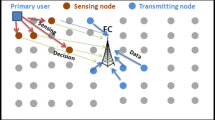Abstract
This paper will address sensor selection problem for spectrum sensing in a cognitive radio network. The sensor’s limited energy is an important issue which has attracted more attention in recent years. An energy efficient cooperative spectrum sensing will hereby be proposed when multi-antenna sensors are used. Two decision-making techniques are utilized for the combination of antennas’ signals in each sensor: hard and soft decision-making. OR rule is used for hard decision-making technique while selection combining, equal gain combining and maximum ratio combining (MRC) are used for the soft one. In each combination scheme, the sensor selection is a problem by means of which both the energy consumption is minimized and the detection performance gets satisfied. The problem is solved based on the standard convex optimization method. Simulation results show the achievement of a significant energy saving compared to the networks using single-antenna sensors specifically in low signal to noise ratio state. Among all methods, MRC combining enjoys the least energy consumption, as well; it satisfies the desired detection performance.







Similar content being viewed by others
References
Qu, D., Wang, Z., & Jiang, T. (2010). Extended active interference cancellation for sidelobe suppression in cognitive radio OFDM systems with cyclic prefix. IEEE Transsction On Vehicular Technology, 59(4), 1689–1695.
Haykin, S. (2005). Cognitive radio: brain-empowered wireless communications. IEEE Journal on Selected Areas in Communications, 23(2), 201–220.
Atapattu, S., Tellambura, C., & Jiang, H. (2011). Energy detection based cooperative spectrum sensing in cognitive radio networks. IEEE Transactions on Wireless Communications, 10(4), 1232–1241.
Cabric, D., Tkachenko, A., & Brodersen, R. (2006). Spectrum sensing measurements of pilot, energy, and collaborative detection. In Proceedings of IEEE military communications conference (pp. 1–7). Washington, D.C., USA.
Yucek, T., & Arslan, H. (2009). A survey of spectrum sensing algorithms for cognitive radio applications. IEEE Communications Surveys Tutorials, 11(1), 116–130.
Ghasemi, A., & Sousa, S. (2008). Spectrum sensing in cognitive radio networks: Requirements, challenges and design trade-offs. IEEE Communications Magazine, 46(4), 32–39.
Peh, E., & Liang, Y. C. (2007). Optimization for cooperative sensing in cognitive radio networks. In Proceedings of IEEE communication society, wireless communication and networking conference (pp. 27–32).
Maleki, S., Pandharipande, A., & Leus, G. (2011). Energy-efficient distributedspectrum sensing for cognitive sensor networks. IEEE Sensors Journal, 11(3), 565–573.
Najimi, M., Ebrahimzadeh, A., Andargoli, S. M. H., & Fallahi, A. (2013). A novel sensing nodes and decision node selection method for energy efficiency of cooperative spectrum sensing in cognitive sensor networks. IEEE Sensors Journal, 13(5), 1610–1621.
Ma, W., Wu, M. Q., Liu, D., & Wang, M. L. (2009). User Sensing based on MIMO cognitive radio sensor networks. In Computer science and information technology conference (pp. 205–208).
Ma, W., Hu, S. Z., Wang, Y. C., & Zhu, l. (2009). Cooperative spectrum sensing in OFDM based on MIMO cognitive radio sensor networks. In Wireless communications networking and mobile computing conference (pp. 1–4).
Lee, W., & Cho, D.-H. (2011). Enhanced spectrum sensing scheme in cognitive radio systems with MIMO antennae. IEEE Transactions on Vehicular Technology, 60(3), 1072–1085.
Sklar, B. (1997). Rayleigh fading channels in mobile digital communication systems. I. Characterization. IEEE Communications Magazine, 35(7), 90–100.
Yang, Y., & Blum, R. S. (2007). Energy-efficient routing for signal detection under the Neyman-Pearson criterion in wireless sensor networks. In 6th International symposium on information processing in sensor networks (pp. 303–312).
Peh, E., Liang, Y. C. (2007). Optimization for cooperative sensing in cognitive radio networks. In Wireless communications and networking conference (pp. 27–32).
Win, M. Z., & Winters, J. H. (1999). Analysis of hybrid selection/maximal-ratio combining of diversity branches with unequal snr in Rayleigh fading. IEEE Journal.
Karagiannidis, G. K., Zogas, D. A., & Kotsopoulos, S. A. (2004). Statistical properties of the EGC output SNR over correlated Nakagami-m fading channels. IEEE Transactions on Wireless Communications, 3(5), 1764–1769.
Shah, A., & Haimovich, A. M. (2000). Performance analysis of maximal ratio combining and comparison with optimum combining for mobile radio communications with cochannel interference. IEEE Transactions on Vehicular Technology, 49(4), 1454–1463.
Heinzelman, W., Chandrakasan, A. P., & Balakrishnan, H. (2002). An application-specific protocol architecture for wireless microsensor. IEEE Transaction on Wireless Networking, 1(4), 660–670.
IEEE 802.15.4 Standard. (2006). Wireless medium access control (MAC) and physical layer (PHY) specifications for low-rate wireless personal area networks (WPANs), part 15.4.
Yang, B., Letaief, Kh B, & Cheng, R. S. (2000). Timing recovery for ofdm transmission. IEEE Journal Selected Areas Communications, 18(11), 2278–2291.
Boyd, S., & Vandenberghe, L. (2004). Convex optimization. Cambridge: Cambridge University Press.
Author information
Authors and Affiliations
Corresponding author
Rights and permissions
About this article
Cite this article
Hojjati, S.H., Ebrahimzadeh, A., Andargoli, S.M.H. et al. Energy efficient cooperative spectrum sensing in wireless multi-antenna sensor network. Wireless Netw 23, 567–578 (2017). https://doi.org/10.1007/s11276-015-1175-x
Published:
Issue Date:
DOI: https://doi.org/10.1007/s11276-015-1175-x




